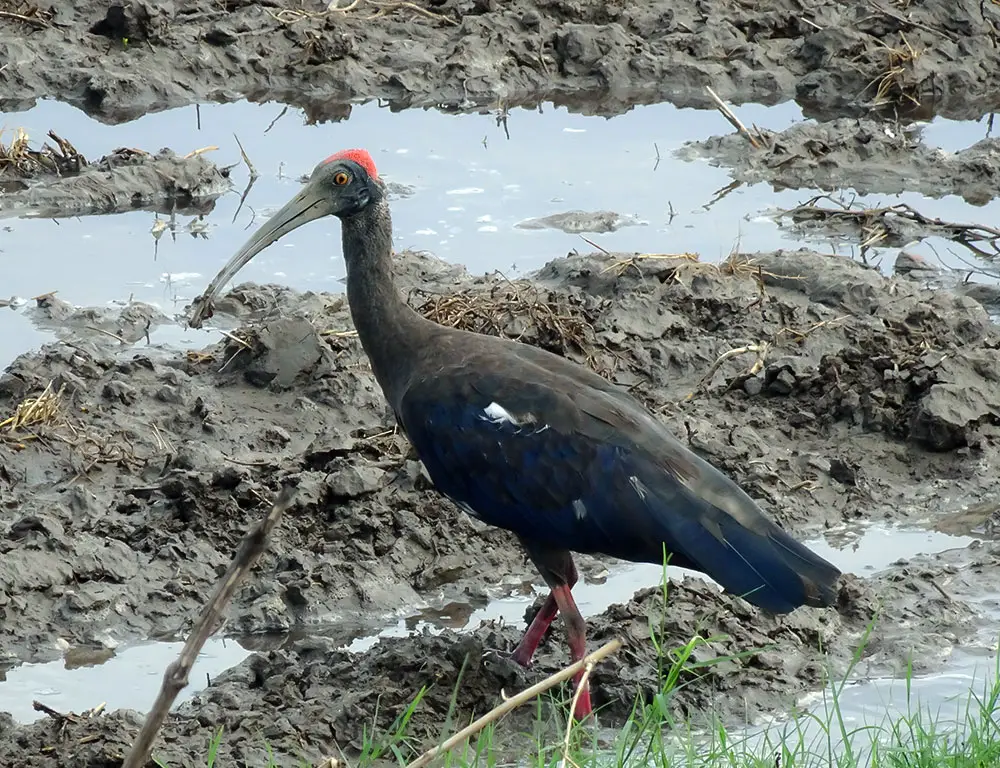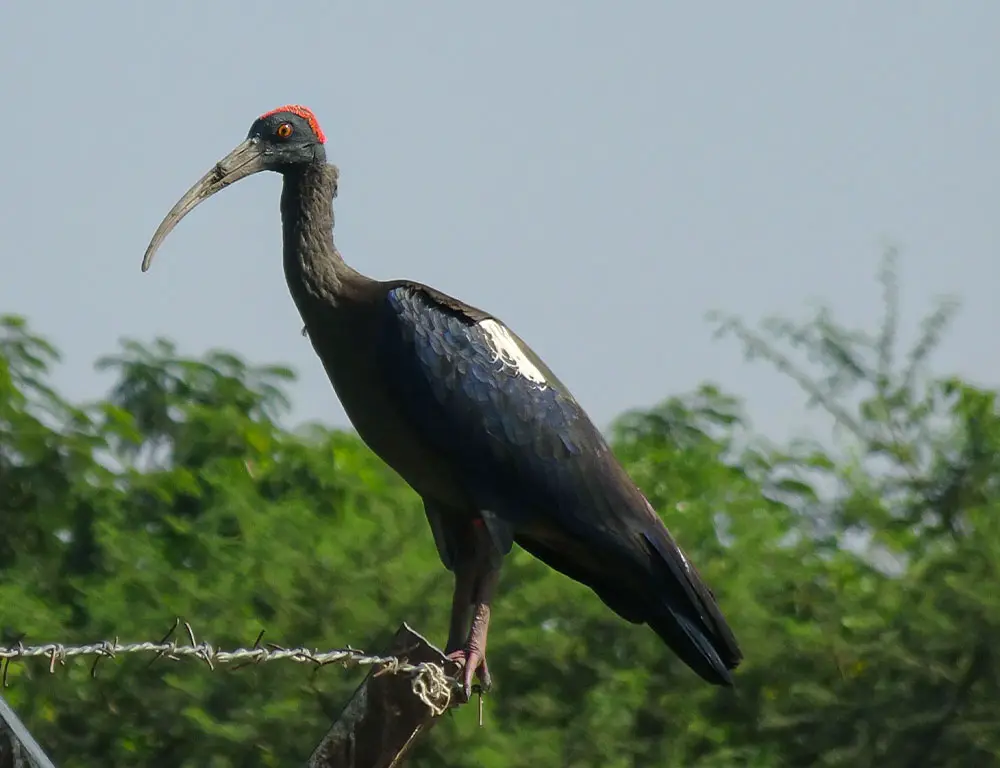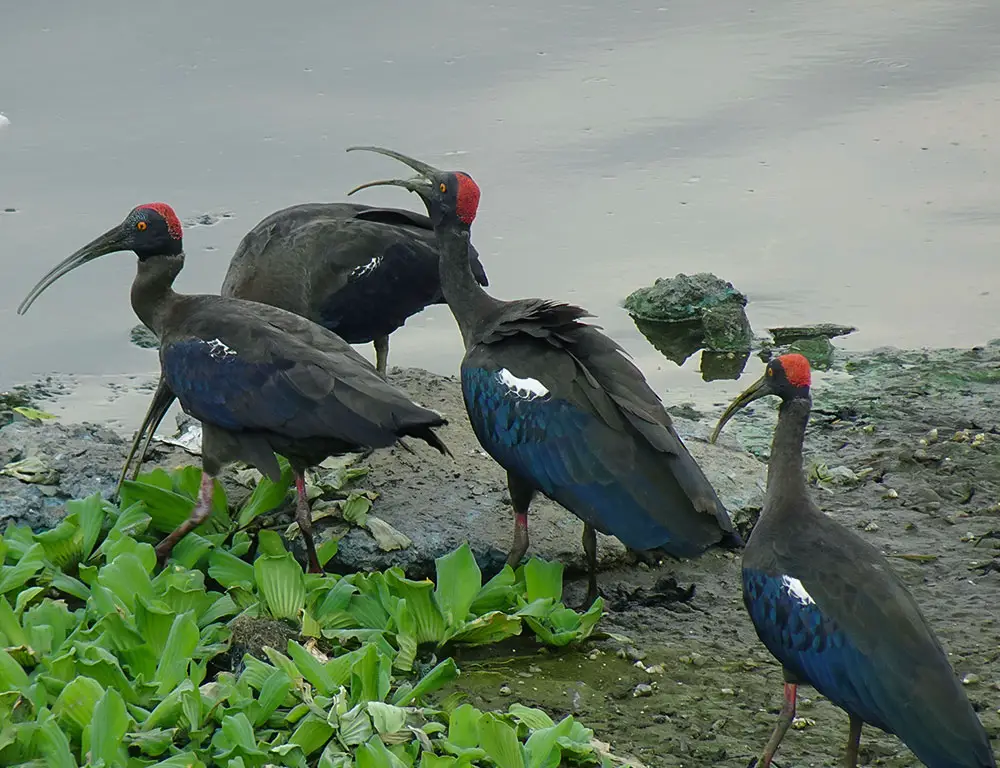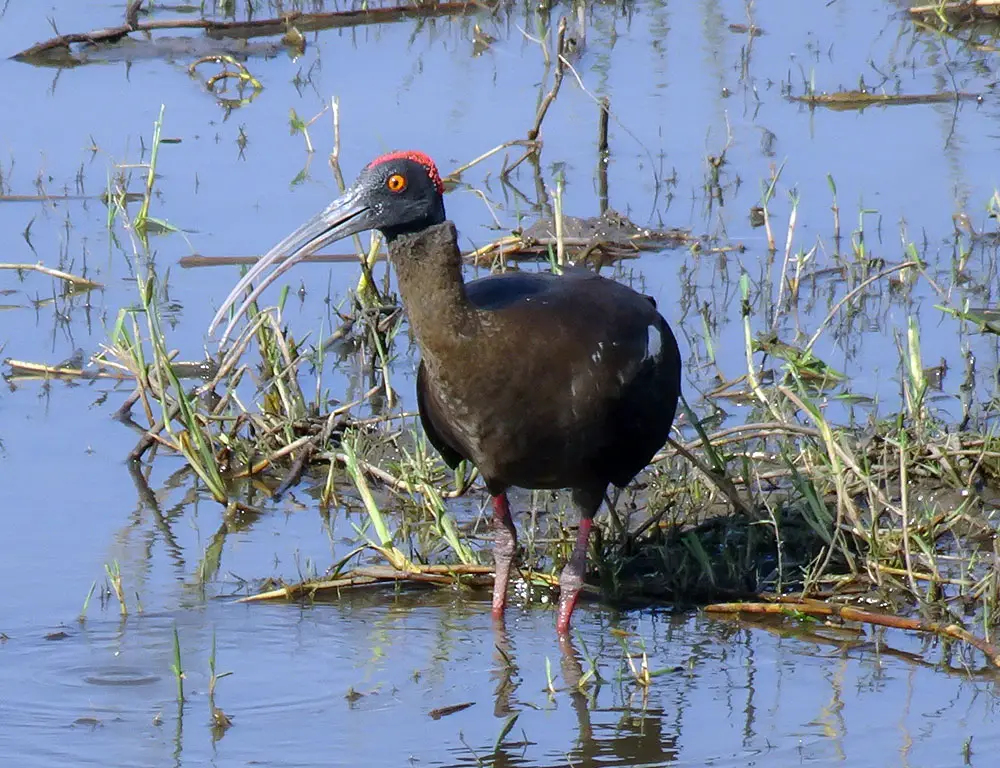When folks think of striking, unique birds, the Red-Naped Ibis should spring to mind. Known scientifically as Pseudibis papillosa, this bird stands out in its native habitats across India and Southeast Asia.
Its long legs, curved beak, and distinctive red patch at the back of its head (hence the name “Red-Naped”) set it apart from other ibises.
I’ve had quite an experience observing these fascinating creatures in their natural environment. They’re primarily found in marshy wetlands or on the edges of lakes and rivers, where they can easily hunt for their diet of insects, frogs, and small reptiles.
Interestingly, despite their attraction to water bodies for feeding purposes, Red-Naped Ibises are known to nest in trees – often quite far from water.
The more you learn about the Red-Naped Ibis, the more there is to admire. These birds aren’t just beautiful, incredibly resilient, and adaptable – traits that have allowed them to survive amidst rapidly changing environments throughout their range.
Studying these fantastic creatures can provide valuable insights into avian biology and broader ecological principles.
Physical Characteristics of the Red-Naped Ibis

With its striking appearance, the Red-Naped Ibis offers a captivating blend of colors and features that make it stand out among avian species.
Here’s a detailed overview of its physical characteristics:
Body Coloration
The Red-Naped Ibis has a predominantly black body, but upon closer inspection, one can observe subtle green and purple iridescence on its wings. This iridescence adds to its allure, especially when the bird catches the light.
Red Patch on the Nape
As its name suggests, one of the most distinctive features of this bird is the red patch on the nape, which contrasts beautifully with the predominantly black plumage.
Legs
Its long, reddish-brown legs facilitate its movement in various habitats, particularly in shallow water bodies where it often forages for food.
Bill
The Red-Naped Ibis is equipped with a long, curved bill well-adapted for probing mud and shallow waters in search of prey. This specialized bill shape aids in capturing tiny aquatic organisms with precision.
Eyes
Its eyes are characterized by a piercing yellow coloration, which adds a vibrant splash to its facial features.
Size and Weight
An adult Red-Naped Ibis typically measures 68-72 cm (27–28 inches) in total length from head to tail. It weighs around 1.15 kg (2.5 lbs), making it a medium-sized bird.
Additionally, its wingspan averages about 105-115 cm (41-45 inches), showcasing impressive dimensions when fully extended.
Sexual Dimorphism
Interestingly, there isn’t much difference between males and females in size or coloration. Both genders exhibit similar physical characteristics, contributing to the challenge of distinguishing between them solely based on appearance.
Habitat and Distribution of the Red-Naped Ibis

The Red-Naped Ibis is a versatile bird in habitat selection, demonstrating its ability to thrive in various environments.
Here’s an overview of its habitat preferences and distribution:
Habitat Preferences
Red-naped ibises favor wetlands and marshes, where they can find ample food resources such as aquatic invertebrates and small vertebrates. However, they also adapt well to human-altered landscapes, including cultivated fields and urban parks.
This adaptability allows them to inhabit various habitats, from coastal regions to inland areas.
Distribution
The primary range of the Red-Naped Ibis encompasses the Indian Subcontinent, including countries such as Pakistan, India, Nepal, and Sri Lanka.
Within this region, they are distributed across various ecosystems, from the Himalayan foothills to coastal plains.
Despite their broad distribution, they tend to be more concentrated in areas with suitable wetland habitats.
Non-Migratory Behavior
Unlike some bird species, Red-Naped Ibises are non-migratory. They typically remain in that area year-round once they establish their territory within a suitable habitat. This sedentary behavior contributes to their local presence and attachment to specific regions.
Challenges and Threats
While these birds exhibit adaptability to different habitats, they face threats from human activities such as wetland drainage for agriculture and rapid urbanization.
These changes in land use patterns can disrupt their natural habitats and reduce available food sources, threatening their population viability.
Elusive Nature
Despite their relatively widespread distribution, Red-Naped Ibises can be challenging to spot due to their dark plumage, which provides effective camouflage against dense vegetation.
However, keen observers may detect their presence by listening to their distinctive calls, which can help locate these elusive birds in their habitats.
Behavior and Diet of the Red-Naped Ibis

The behavior and diet offer fascinating insights into its ecological role and adaptations. Here’s a closer look at these aspects:
Behavior
- Ground Dwelling: Red-naped ibises are primarily ground-dwelling birds, preferring to walk or run on the ground rather than flying. This behavior is typical of many ibis species and is likely adapted to their foraging habits and habitat preferences.
- Flight: While they are adept walkers, Red-Naped Ibises are proficient flyers. They typically fly in straight paths with slow, steady wingbeats. Despite their ability to fly, they often roost in trees at night, demonstrating a preference for elevated perches for resting and sleeping.
- Social Behavior: These birds exhibit sociable tendencies, often seen in pairs or small groups, particularly during breeding. This social behavior may serve various purposes, including mate selection, communication, and protection from predators.
Diet
- Insects: The Red-Naped Ibis relies heavily on insects as a primary food source, constituting approximately 50% of its diet. Insects provide essential nutrients and energy for these birds and are likely abundant in the wetland and marsh habitats they frequent.
- Small Vertebrates: Frogs and fish comprise a significant portion (around 30%) of the Red-Naped Ibis’s diet. These small vertebrates are likely abundant in the same habitats where the ibises find their insect prey.
- Grains & Seeds: Red-naped ibises consume grains and seeds, comprising about 20% of their diet. This dietary diversity allows them to exploit various food resources and adapt to changing environmental conditions.
Feeding Behavior
- Probing: Red-naped ibises employ a feeding strategy of probing into soft soil with their long bills to extract insects, small vertebrates, and other prey items. This behavior efficiently captures buried or hidden prey and demonstrates their adaptability to diverse feeding habitats.
- Ecological Role: Red-naped ibises are vital in controlling pest populations and maintaining ecosystem balance by feeding on insects and small vertebrates. Their foraging activities contribute to the health and functioning of wetlands and marsh ecosystems where they are found.
Conservation Status of the Red-Naped Ibis

The conservation status of the Red-Naped Ibis reflects its current population trend and the potential threats it faces in its habitats.
Here’s a summary of its conservation status and the factors influencing its survival:
IUCN Red List Status
The Red-Naped Ibis is classified as “Least Concern” on the International Union for Conservation of Nature (IUCN) Red List. This designation indicates that the species is not currently facing imminent extinction risk.
However, it does not imply that conservation efforts are unnecessary.
Population Trend
The population trend of the Red-Naped Ibis is generally stable, according to assessments by BirdLife International. This stability suggests that the species is maintaining viable populations within its range.
Threats
- Habitat Loss: One of the primary threats to the Red-Naped Ibis is habitat loss due to agricultural expansion and urbanization.
The conversion of wetlands and marshes for agricultural purposes and the encroachment of urban areas into their habitats diminish available foraging and nesting sites. - Pollution: Pollution, particularly from pesticides and other chemicals used in farming practices, threatens Red-Naped Ibises.
These birds are sensitive to pollutants, which can accumulate in their food sources and adversely affect their health and reproductive success.
Population Estimates
- South Asia: The estimated population of Red-Naped Ibises ranges from 10,000 to 100,000 individuals. This region encompasses countries such as India, Pakistan, Nepal, and Sri Lanka, where the species is predominantly found.
- Southeast Asia: The population of Red-Naped Ibises in Southeast Asia is currently unknown, indicating a gap in data availability for this region.
Conservation Efforts
While the Red-Naped Ibis is not currently classified as endangered or threatened, conservation efforts are crucial to ensure its long-term survival.
Initiatives such as habitat protection, pollution control measures, and community-based conservation projects can help mitigate threats and safeguard the species and habitats.
Conclusion
I’ve spent considerable time researching and writing about the Red-Naped Ibis. It’s clear to me that this avian species is not just another bird but an intriguing creature with unique characteristics.
With its striking appearance and fascinating behavior, the Red-Naped Ibis has proven to be a captivating subject. Its distinctive red nape, glossy black body, and long curved beak set it apart in the bird world.
This bird’s ability to adapt to different environments – from wetlands to grasslands – further demonstrates its resilience.
But what caught my attention was how the Red-Naped Ibis is vital in maintaining our ecosystem. By feeding on various insects and small animals, they help control pest populations. This fact alone makes them an essential part of our biosphere.
Despite their significance, these birds face habitat loss and degradation threats. We must emphasize the importance of conservation efforts to preserve their natural habitats.
Let us not forget – every creature has a significant role in maintaining ecological balance.
In summing up, let me leave you with some compelling facts about the Red-Naped Ibis:
- The average lifespan: 25 years
- Predominant habitats: Wetlands and grasslands
- Primary diet: Insects and small animals
- Current conservation status: Least Concern (according to the International Union for Conservation of Nature)
To wrap things up, it’s been quite an enlightening journey delving into the life of this remarkable bird species. The more we learn about creatures like the Red-Naped Ibis, the better we understand our planet’s intricate web of life.